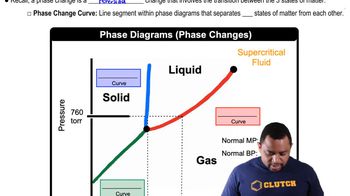Here are the essential concepts you must grasp in order to answer the question correctly.
Phase Changes
Phase changes refer to the transitions between different states of matter, such as solid, liquid, and gas. In the context of CO2, these changes include sublimation (solid to gas) and deposition (gas to solid). Understanding these transitions is crucial for analyzing how CO2 behaves under varying temperature and pressure conditions.
Recommended video:
Phase Diagrams
A phase diagram is a graphical representation that shows the phases of a substance at different temperatures and pressures. It helps predict the state of a substance under specific conditions. For CO2, the phase diagram indicates the boundaries between solid, liquid, and gas phases, which are essential for determining the phase changes occurring at 3 atm pressure.
Recommended video:
Phase Changes in Diagrams
Critical Point
The critical point is the temperature and pressure at which the distinction between liquid and gas phases disappears. For CO2, this point is significant because it defines the conditions under which CO2 can exist as a supercritical fluid. Understanding the critical point is important for predicting the behavior of CO2 when heated from -80 to -20°C at a constant pressure of 3 atm.
Recommended video:




